Images of Females in Chinese History
Thematic Gallery (5),
Hong Kong Heritage Museum
29 May 2002 - 28 August 2002
Nowadays woman assumes many different roles in the society. She may be an efficient working colleague in the workplace as well as a gentle and helpful wife in a family. What were the images and living styles of women in ancient China when the economic and social environment was totally different from ours?
Women Identity and Costumes in Chinese History exhibition was the first of an exhibition series for the Women Festival this year. In the exhibition the transformation of women images and lifestyles from the Warring States Period to the Qing dynasty were illustrated with over 100 items of valuable exhibit including pottery figures, brick engraving, costumes, accessories, scrolls etc. provided by the National Museum of Chinese History. The exhibition also featured achievements of several prominent women in Chinese history such as Cai Yan, a poet of the Eastern Han dynasty and Empress Wu Cetien of the Tang dynasty.
Ms Lee Wai Chun, a local famous comic strip writer, developed several images of the character "13 dots" groomed with historical costumes and headgears. The images were transformed into an interactive game set up in the gallery. Exhibition catalogue and pamphlet were issued to provide visitors with more information on the identity and costumes of Chinese women.
Exhibit Highlights

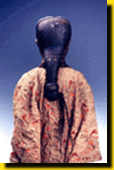
|
Painted wooden burial figures of female attendants (replica)
Western Han dynasty (206 BC - AD 8)
Height 73 cm
Excavated from Han Tomb No. 1 at Mawangdui,
Changsha, Hunan province in 1972
Original figures in the Hunan Provincial Museum
The woman has hair parted in the centre, gathered at the back and wound into a chignon well below the nape of the neck and from which a tress of hair hangs at the right, a style referred to as duoma ji, falling-off-the-horse chignon. Her eyebrows are painted black, her lips red. She wears a shenyi robe with large sleeves made of silk embroidered with swirling cloud forms and curling flowers and foliage; the brocade border has a lozenge motif. Her shoes have forked tips.
|
|
 |
 |
Pottery burial figurine of woman
Eastern Jin dynasty (317-420)
Height 34.1 cm
Excavated in Shashishan, Nanjing, Jiangsu province in 1955
The faintly smiling female attendant holds her hands together inside her sleeves. Her chignon is covered with a headscarf. She wears an upper garment and a flared skirt.
|
 |
|
 |
 |
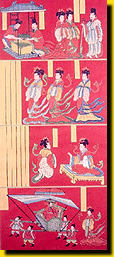 |
Lacquer painting of figures (reproduction)
Northern Wei dynasty (386-534)
Height 78.8 cm width 33 cm
Excavated from the tomb of Sima Jinnong in Datong, Shanxi province in 1965 - 1966
Original painting in Datong Museum, Shanxi province
Sima Jinnong was a scion of the Jin royal family. His father was a high official of the Eastern Jin, but surrendered to the Wei. Of the lacquer paintings unearthed from the tomb, five were relatively intact, and they were painted on both sides. This example is divided into four registers. There are inscriptions identifying the figures and the subjects on the original painting. The stories are taken from Lie nu zhuan by Liu Xiang of the Western Han. All the women in the painting arrange their hair in high chignons, and wear buyao movable hair ornaments. Their outfits of wide-sleeved long robes crossed at the neck reflect the shenyi tradition. Streamers flutter behind.
|
|
 |
 |
Painted pottery burial figurine of woman polo player
Tang dynasty (618-907)
Height 32 cm, length 29 cm
Excavated from the tomb of Wei Jiong in Chang'an county, Shaanxi province in 1959
Wei Jiong was a brother of Empress Wei, consort of emperor Zhongzong of the
Tang dynasty. Polo was introduced into China in the early Tang, and under the energetic patronage of Tang Taizong, it became an extremely popular sport both at court and among the common people. Tang ladies donned various outfits when playing polo: woman's clothing, man's clothing or northwestern ethnic clothing. Here the woman sits astride the horse, body turned slightly to the right. Her hair, parted in the centre, is done in two buns. She wears a northwestern ethnic outfit of belted three-quarter length green robe with red lapels, red trousers and black boots.
|
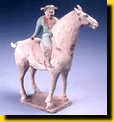 |
|
 |
 |
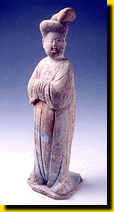 |
Painted pottery figure of woman
Tang dynasty (618-907)
Height 62.5 cm
Excavated in Hansenzhai, Xi'an, Shaanxi province in 1952
The woman's high chignon is thrust to the left. The cheeks are plump, the nose is straight and the mouth small. She wears an upper garment of low neck line and a high-waisted long skirt.
|
|
 |
 |
Ladies Wearing Flowers
Attributed to Zhou Fang, Tang dynasty
(618-907)
Height 53 cm width 187 cm
Graphic print reproduction
Original painting in the Liaoning Provincial Museum
The women's hair is done up in towering chignons, and decorated with flowers or buyao ornaments with swaying appendages. Their eyebrows are finely painted, their foreheads adorned with pasted decorative motifs. They all wear a low-cut long gown over which is a robe with centre opening and voluminous sleeves, made of a fabric so sheer that the arms are visible. In addition they wear an embroidered shawl.
|

 |
|
 |
 |
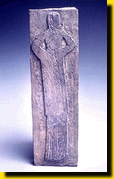 |
Pictorial brick: woman doing her hair
Northern Song dynasty (960-1127)
Height 37.3 cm width 11.3 cm
As a finishing touch the woman is tying a ribbon to her hair which is piled high in a chignon around which is a shankou guan headdress. She wears a moxiong, an inner garment which covers the breasts and the abdomen, a long skirt and a beizi jacket. Hanging from her waist is a long ribbon tied in a decorative knot. Her shoes have upturned pointed tips.
|
|
 |
 |
Copy of the
Worshipping the Weaver Maid by Qiu Ying
Anonymous, Ming dynasty (1368-1644)
Handscroll, height 29.8 cm, width 377 cm
In ancient China there was the folk tradition of women appealing to the Weaver Maid for manual dexterity on qixi, the evening of the seventh day of the seventh lunar month. The women in a garden setting this painting have hair done up in different varieties of chignon. They wear upper garment and skirt, some with a shawl draped over the shoulders. Some wear a waist band or a ribbon tied with a fancy knot.
|


|
|
 |
 |
 |
Gold phoenix hairpin
Ming dynasty (1368-1644)
Overall height 22.3 cm
Excavated from the tomb of King Yizhuang in Nancheng county, Jiangxi province in 1958
The head of the hairpin is in the form of a standing phoenix. The pin is inscribed "Made in the Silver Workshop for the palace in the tenth month of the twenty-second year of Yongle [1424], with 2 liang [100 gm] of 90% gold and 2 fen [1 gm] of soldering material"
|
|
 |
 |
Woman's upper garment of sky blue gauze and elaborate borders
Qing dynasty (1644-1911)
Length 97.5 cm, greatest width 143 cm, sleeve hem widths 46 cm, hem widths 93 cm
The garment with low stand-up collar and wide sleeves opens on the right with two pairs of double toggles. The sky blue gauze is woven with a pattern of endless knots and stylized shou characters. A very wide border in several stripes of varying widths, including two black narrow stripes, and variously embroidered with bats, plum blossoms and bamboo, and floral sprigs ornament the collar, the opening, the hems and the sleeves. Garments with this style of decorative border were very trendy in the late Qing period.
|
 |
|
 |
 |
Other Past Exhibitions
|












